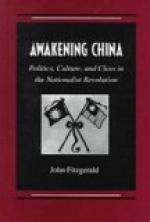Beyond the eastern extremity of the Great Wall, bounded on the west by Mongolia, on the north by the Amur, on the east by the Russian seaboard, and on the south by Korea and the Gulf of Pechili, lies the home of the Manchus—the race now dominant in the Chinese Empire. China claims it, just as Great Britain claimed Normandy, because her conquerors came from that region; and now that two of her neighbours have exhausted themselves in fighting for it, she will take good care that neither of them shall filch the jewel from her crown.
That remarkable achievement, the conquest of China by a few thousand semi-civilised Tartars, is treated in the second part of this work.
Manchuria consists of three regions now denominated provinces, Shengking, Kairin, and Helungkiang. They are all under one governor-general whose seat is at Mukden, a city sacred in the eyes of every Manchu, because there are the tombs of the fathers of the dynasty.
The native population of Manchuria having been drafted off to garrison and colonise the conquered [Page 57] country, their deserted districts were thrown open to Chinese settlers. The population of the three provinces is mainly Chinese, and, assimilated in government to those of China, they are reckoned as completing the number of twenty-one. Opulent in grain-fields, forests, and minerals, with every facility for commerce, no part of the empire has a brighter future. So thinly peopled is its northern portion that it continues to be a vast hunting-ground which supplies the Chinese market with sables and tiger-skins besides other peltries. The tiger-skins are particularly valuable as having longer and richer fur than those of Bengal.
Of the Manchus as a people, I shall speak later on.[*] Those remaining in their original habitat are extremely rude and ignorant; yet even these hitherto neglected regions are now coming under the enlightening influence of a system of government schools.
[Footnote *: Part II. page 140 and 142; part III, pages 267-280]
Mongolia, the largest division of Tartary, if not of the Empire, is scarcely better known than the mountain regions of Tibet, a large portion of its area being covered with deserts as uninviting and as seldom visited as the African Sahara. One route, however, has been well trodden by Russian travellers, namely, that lying between Kiachta and Peking.
In the reign of Kanghi the Russians were granted the privilege of establishing an ecclesiastical mission to minister to a Cossack garrison which the Emperor had captured at Albazin trespassing on his grounds. Like another Nebuchadnezzar, he transplanted them to the soil of China. He also permitted the Russians [Page 58] to bring tribute to the “Son of Heaven” once in ten years. That implied a right to trade, so that the Russians, like other envoys, in Chinese phrase “came lean and went away fat.” But they were not allowed to leave the beaten track: they were merchants, not travellers. Not till the removal of the taboo within the last half-century have these outlying dependencies been explored by men like Richthofen and Sven Hedin. Formerly the makers of maps garnished those unknown regions




